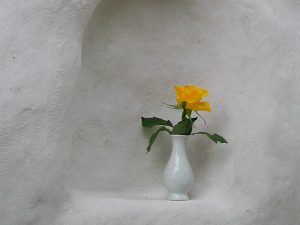This section contains specific information for straw-bale buildings. It’s best to let the building settle for as long as possible after building, before you render it. This is obviously much more important for a structure with load-bearing walls than for one with a timber frame in-fill. Otherwise, the render may crack; however, lime renders are very easy to repair. Lime putty stores forever as long as it is kept under a film of water in a plastic bucket with a lid, so you can knock some up with some sharp sand any time you need to do some repairs.
Straw-bale buildings must not be covered in a non-breathable material because the bales will rot. So cement renders, plastics or any waterproof material is out. Good coverings include earth or clay plasters, timber cladding, or lime renders – or a combination of these.
We found the best way to apply render to straw-bale walls was to use rubber gloves, take a dollop of render in your left hand (or your right if you’re left-handed) and push it into the wall with the thumb of your other hand, moving the hand with the render until it is all pushed in. Then smear over the render you have just applied. See what works best for you – and practice makes perfect.
It’s a great idea to have a party, get all your friends over for the weekend, supply them with beer, and get them all rendering. Many hands make light work, and it’s not skilled work.
With straw-bale walls, or or even rammed earth walls, some books suggest fixing chicken wire to the walls before rendering. We don’t think this is a particularly good idea, as you should be trying to get good adhesion to the wall itself. If the render is secured to the chicken wire and not the wall, it could bow away from the wall and crack, allowing moisture in. If it is securely adhered to the wall, it can’t. Natural materials such as straw or earth provide a good base for a lime render or slurry, and don’t need chicken wire to be added.
With straw-bale buildings, allow the plaster / render to follow the lines of the building – don’t worry if it’s not perfectly square. A visitor to Redfield who has built straw-bale buildings in the States, Europe and Mexico noted that Europeans and Americans wanted the render to follow the natural contours of the building, to look curvy and organic, but in Mexico they wanted perfectly straight lines; in fact they wanted cement render too, to hide the fact that it was a straw-bale building at all.
If you are intending to lime render a straw-bale building, it’s better not to lay the bales on their side (to create thinner walls). Lay the bales flat, so that you are presented with cut or folded ends of straw, not long lengths, which are very difficult to render. We have a shed with bales laid on their sides, and the first layer of render we put on fell off. It’s much easier to push render into the cut or folded ends of the straw, and it stays on much better too.
Render both sides of wall at the same time – otherwise one side of the wall will be much heavier than the other, and may bow out.
Use cob to fill holes in straw-bale walls before rendering.
 |

